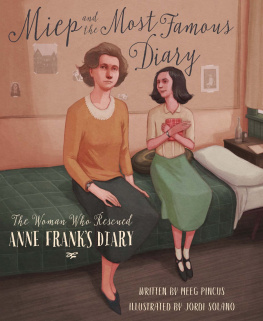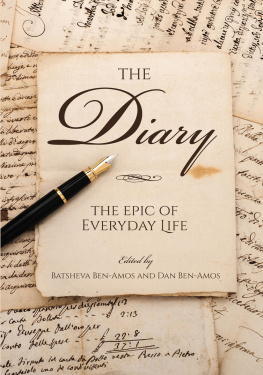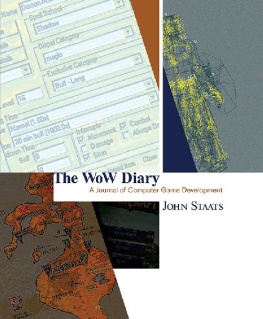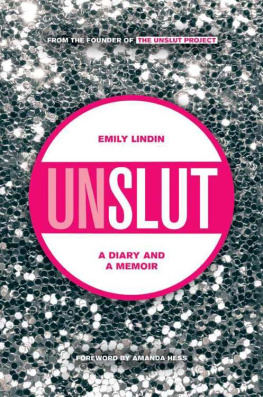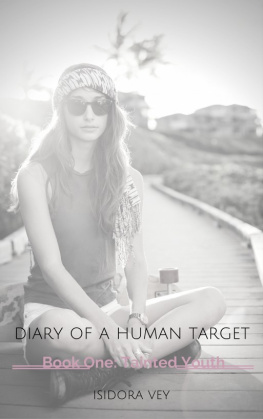Diary Method
Bloomsbury Research Methods
Edited by Graham Crow and Mark Elliot
The Bloomsbury Research Methods series provides authoritative introductions to a range of research methods which are at the forefront of developments in a range of disciplines.
Each volume sets out the key elements of the particular method and features examples of its application, drawing on a consistent structure across the whole series. Written in an accessible style by leading experts in the field, this series is an innovative pedagogical and research resource.
Also available in the series
Community Studies , Graham Crow
GIS , Nick Bearman
Inclusive Research , Melanie Nind
Qualitative Longitudinal Research , Bren Neale
Quantitative Longitudinal Data Analysis , Vernon Gayle and Paul Lambert
Rhythmanalysis , Dawn Lyon
Forthcoming in the series
Embodied Inquiry , Jennifer Leigh and Nicole Brown
Statistical Modelling in R , Kevin Ralston, Vernon Gayle, Roxanne Connelly and Chris Playford
Diary Method
Research Methods
Ruth Bartlett and Christine Milligan
Contents
The idea behind this book series is a simple one: to provide concise and accessible introductions to frequently used research methods and of current issues in research methodology. Books in the series have been written by experts in their fields with a brief to write about their subject for a broad audience.
The series has been developed through a partnership between Bloomsbury and the UKs National Centre for Research Methods (NCRM). The original What is? Research Methods Series sprang from the eponymous strand at NCRMs Research Methods Festivals.
This relaunched series reflects changes in the research landscape, embracing research methods innovation and interdisciplinarity. Methodological innovation is the order of the day, while still maintaining an emphasis on accessibility to a wide audience. The format allows researchers who are new to a field to gain an insight into its key features, while also providing a useful update on recent developments for people who have had some prior acquaintance with it. All readers should find it helpful to be taken through the discussion of key terms, the history of how the method or methodological issue has developed, and the assessment of the strengths and possible weaknesses of the approach through analysis of illustrative examples.
This book is devoted to diary method, which is an approach to analysing social life that has been used by researchers in the social sciences for a long time, but which is enjoying growing popularity as a result of both technological and social changes. As Ruth Bartlett and Christine Milligan show, contemporary researchers have been alive to the possibilities of new technologies being employed to capture peoples behaviour and perceptions close to the points in time that they occur, and in a way that is convenient to research participants. The authenticity of the material collected through the use of the diary method is a further attraction of the approach for both participants and researchers, and this also helps to explain why this way of capturing the social world is marked by so much enthusiasm. Keeping a record of time use and timings can be a revelation to people who keep diaries as well as to researchers, and the purpose of charting the rhythms and routines in everyday life is readily apparent in a whole range of fields, including health behaviours and domestic life. Inevitably, of course, there are ethical as well as practical challenges to the use of an approach that tracks peoples lives over time, and the potentially intrusive and time-consuming character of diary research means that it will not be appropriate for all areas of social scientific investigation. Nevertheless, the vibrancy of the field is nicely illustrated by the remarkable extent to which the book is able to draw upon recently published studies that have employed diary methods, and all the indications are that diaries will only grow in importance as part of the social scientists toolkit.
The books cannot provide information about their subject matter down to a fine level of detail, but they will equip readers with a powerful sense of reasons why it deserves to be taken seriously and, it is hoped, with the enthusiasm to put that knowledge into practice
Everyone understands the idea of a diary. We have all kept a diary for various reasons and in various ways. For some people it may simply be used as a reminder for appointments or events, detailing where they need to be and what they need to be doing at different times; others may keep a more detailed diary or personal account of what they are doing and perhaps what they were thinking and feeling at the time. Individuals often develop personal preferences, routines and systems for keeping a personal diary and choose to keep what they record private. Others may choose, or be invited, to publish their diary; think, for example, of the British journalist and political aide Alastair Campbell who has published three volumes of diaries about his time serving alongside the then Prime Minister, Tony Blair. For many people, there is something inherently absorbing about writing and/or reading someone elses personal diary.
In this book, we review and discuss how diary method has been used by researchers in the social and health sciences and suggest that technologies and modern forms of communication are transforming this method of data collection. Diary method has arguably been the poor relation of the methodological family in qualitative research, compared, for example, to interviews. As with a flexible tool for collecting rich data, especially in light of digital, web and social networking technologies. In this book, we therefore aim to clarify the role of diary method in the researchers toolkit and illustrate through empirical examples the value and limitations of this method for eliciting information and engaging participants in research. In particular, we consider a range of structured, semi-structured and unstructured approaches to diary method; some of the practical issues in designing diary research; and how this method can be modified and used to enable participants to take part in a study and have control over the process of data collection.
A distinctive feature of this book is the consideration given to how and why the diary method is used and might be modified for children and for adults who are frail or physically, cognitively or intellectually impaired in some way. Rather than assuming capacity (like standard research texts) we will discuss the strengths (and limitations) of utilizing diary method to collect data from people who may experience problems in remembering, writing, talking, thinking clearly and using diary-keeping equipment, such as electronic diaries and cameras. We discuss the importance and implications of modifying the diary method in the context of emerging inclusive research methodologies and outline the ways in which researchers have adapted the method to enable the participation of different groups in research.
Another distinctive feature of this book is the consideration given to technologies and modern forms of communication. As other researchers in this series have noted, probably the most significant development in research methods in the past decade is the advancement of digital technologies (Wiles, . In this sense, the book fits well with the What is? series, as we consider the value of diary method not only from a historical and present-day perspective, but also its future potential in the hyper-digital age.



